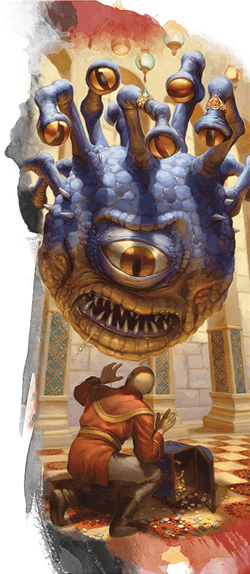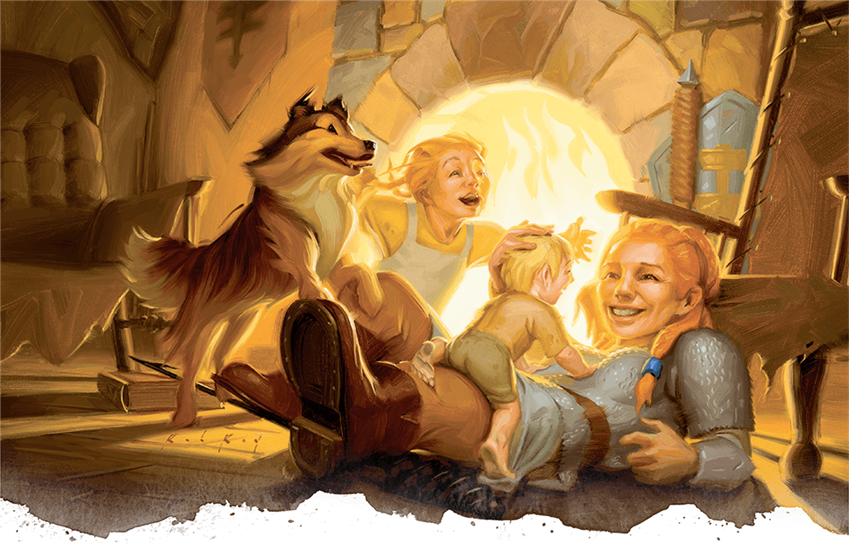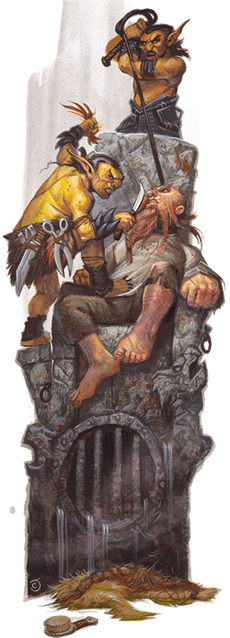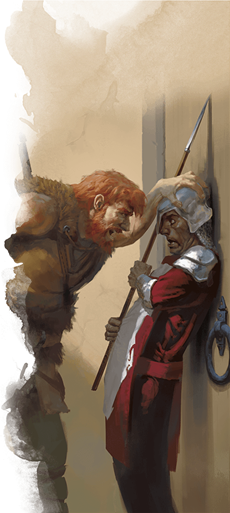 Adventuring in the big city poses big challenges for some gaming groups. Players need to think about how to get what they want without simply killing their way through problems. Consider what happens in a game like Oblivion or Skyrim when you commit a crime in front of the guards. And while Waterdeep: Dragon Heist provides the broad strokes of the city’s Code Legal to help DMs adjudicate the consequences of the player character’s reckless actions, simply punishing your players for playing D&D the way they want to isn’t exactly fun.
Adventuring in the big city poses big challenges for some gaming groups. Players need to think about how to get what they want without simply killing their way through problems. Consider what happens in a game like Oblivion or Skyrim when you commit a crime in front of the guards. And while Waterdeep: Dragon Heist provides the broad strokes of the city’s Code Legal to help DMs adjudicate the consequences of the player character’s reckless actions, simply punishing your players for playing D&D the way they want to isn’t exactly fun.
Waterdeep: Dragon Heist and Encounters in Sharn (by the DMs Guild Adepts) are both major urban adventures, set in the fantasy metropoles of Waterdeep (in the Forgotten Realms) or Sharn (in the Eberron campaign setting). Both of these adventures dabble in the themes and styles of gangster films, film noir, and heist movies like Ocean’s 11 (or the recent Ocean’s 8!), and both take place in big cities that operate just a little bit differently from the usual wilderness and ancient ruins of more traditional D&D adventures.
It may sound like a lot of work to prepare yourself for an adventure focused around character motivations and intrigue instead of dungeon crawling and casual monster-killing, but it’s actually very easy! Here are three tips to help both players and Dungeon Masters alike have a great time playing in your upcoming urban intrigue game, whether it’s Waterdeep: Dragon Heist or any other adventure.
For DMs: All Aboard?
The quickest way to ensure that your campaign will fail is if the players don’t like what the campaign is about, so make sure they know that your campaign is about urban intrigue. If you’re a Dungeon Master planning an urban intrigue campaign, make sure that your players know exactly what they’re getting into. When people think of a Dungeons and Dragons campaign, their logical first thought will be that the story is all about exploring dungeons and fighting dragons, not about hunting thieves atop the rooftops of a busy city, dodging the city watch, and hunting the sewers for the agents of the Xanathar.
And go the extra mile: when you say your campaign is about “urban intrigue,” make sure that your players know what that means! This is the spiel I give people about Waterdeep: Dragon Heist. Feel free to steal and modify it to help pitch this game to your group:
“In this story, you are D&D heroes with swords and magic living in fantasy New York City. A lot of normal people live here trying to get by, but the city is really run by monstrous crime lords, secret nobility, and a lot of evil people trying to get very, very rich. But since this is a city with laws and a police force, you have to act like detectives or vigilantes to get results, like Batman or Robert Downey Jr.’s Sherlock Holmes. Words are weapons, and it’s better to bring villains down by revealing their deep dark secrets than by killing them with a sword.”
And ask your players if they’re interested. If they’re all opposed to it, that’s a clear sign that you need to find something else. On the other hand, if there are just one or two players on the fence, you can easily run an urban campaign if you balance out their needs.

For Players: Make Thematic Characters
Conan the Barbarian isn’t going to have a good time in the big city. Now, Conan definitely spent time in the city, but look what happened when he did: he got high, punched a camel, and infiltrated a cult. He is a stranger to civilization, and to wasteland wanderers like him, it is “ancient and wicked.” A character like Conan would spend a few moments in the big city, get bored, start a fight, and be swiftly thrown in prison, much to his party members’ annoyance.
If your DM and fellow players want to play a game of urban intrigue, you would be well served to create a character that fits in that genre. This way you not only respect others’ fun, you set yourself up to have fun by creating a character well-equipped to handle the sort of challenges the campaign will throw your way. A barbarian suited only for fighting will have fun when combat encounters arise, but when a campaign is mostly based around infiltrating manor houses, schmoozing with nobility, and hunting for clues in ancient archives? You aren’t doing yourself any favors by playing that kind of character.
That’s not to say you can’t play a character who’s good at fighting in an intrigue game! But consider what their other talents are. In the TV show Leverage, the five members of the main cast fill roles in their heist unit just like how D&D classes fill their roles in an adventuring party. Elliot, the party’s “fighter” is good at more than just punching people, he’s also got a lot of knowledge about mobs and gang activity, and he can be a charming liar and charismatic public face when the situation calls for it. As long as your character has skills and motivations beyond “killing stuff and taking their loot,” you’ll make your intrigue game more fun for everyone.
For DMs: Create Breaks in the Intrigue
 No matter how good your plot is or how much your players love roleplaying, you will get tired. You’ll itch to roll your dice. Wise DMs know when to give in to the urge to hurl monsters at their players, lest you all burn out on roleplaying.
No matter how good your plot is or how much your players love roleplaying, you will get tired. You’ll itch to roll your dice. Wise DMs know when to give in to the urge to hurl monsters at their players, lest you all burn out on roleplaying.
There are plenty of opportunities for the characters to get into monster fights in Waterdeep: Dragon Heist, free of the usual legal ramifications of committing murder. Sewers are everywhere beneath Waterdeep, and the Xanathar’s goblin, kenku, bugbear, and kobold agents use them for rapid travel. They could kidnap a local lordling, giving the characters an opportunity to pursue them and win a reward and gain an ally. Perhaps a black pudding made of congealed excrement and other offal bursts from the pipes and invades the streets, eating horses and terrorizing the local marketplace. Or a group of Zhentarim thieves could break into the player characters’ place of residence, forcing them to nonlethally defend their turf.
All of these options work in Eberron, too if you’re running Encounters in Sharn. But in a city like Sharn where magic is analogous to technology, there are even more outlandish options. Perhaps a shambling mound breaks free of a local wizard’s shop and starts devouring energy from the Lightning Rail. Or maybe an airship crashes in the city streets, swarming with zombies of the crew who were killed and turned into ravenous undead by a mysterious artifact they picked up from Xen’drik. The possibilities are limited only by your imagination, but monstrosities, plants, undead, and fiends are generally acceptable targets for fantasy violence, even in a city regulated by laws against murder.
For Players: Get Involved in the City
 Waterdeep is as much a character as any of the DM’s NPCs. Its many wards all have different moods and treat the characters differently. High-class characters with the noble background may feel out of place among rough-and-tumble sailors in muddy Dock Ward, and common city folk may feel like the North Ward’s suburban atmosphere is a bit too clean for their taste—to say nothing of the opulent extravagance of the Sea Ward. Waterdeep is teeming with personality of its own, to say nothing of the dozens upon dozens of NPCs that live there.
Waterdeep is as much a character as any of the DM’s NPCs. Its many wards all have different moods and treat the characters differently. High-class characters with the noble background may feel out of place among rough-and-tumble sailors in muddy Dock Ward, and common city folk may feel like the North Ward’s suburban atmosphere is a bit too clean for their taste—to say nothing of the opulent extravagance of the Sea Ward. Waterdeep is teeming with personality of its own, to say nothing of the dozens upon dozens of NPCs that live there.
Your character has the opportunity to become involved in the city and make a life there. You aren’t a wanderer, camping out on the side of a road as you travel from ruin to ruin. You may have a regular room in the Yawning Portal Inn and Tavern, and get to know the locals. You might want to start up a business of your own and get to know your neighbors and customers. This creates opportunities for roleplaying, but this is a good idea even if you don’t like roleplaying very much. Making friends with the common people of Waterdeep will help you create valuable alliances that may lead you to finding new adventures, new treasure, and other rewards.
Any Other Ideas?
These are just a few ways for players and DMs alike to make the most out of their urban adventures. It can be hard to stop thinking of all problems in D&D as combat encounters, but when all you have is a hammer, everything looks like a nail. Think of tools to give your players that aren’t focused on combat, and you might see them start trying to solve problems in other ways. What ideas for encouraging intrigue, deceit, and diplomacy over violence have you had in your campaigns?
 James Haeck is the lead writer for D&D Beyond, the co-author of Waterdeep: Dragon Heist and the Critical Role Tal'Dorei Campaign Setting, the DM of Worlds Apart, and a freelance writer for Wizards of the Coast, the D&D Adventurers League, and Kobold Press. He lives in Seattle, Washington with his partner Hannah and his two alley cats, Mei and Marzipan. You can usually find him wasting time on Twitter at @jamesjhaeck.
James Haeck is the lead writer for D&D Beyond, the co-author of Waterdeep: Dragon Heist and the Critical Role Tal'Dorei Campaign Setting, the DM of Worlds Apart, and a freelance writer for Wizards of the Coast, the D&D Adventurers League, and Kobold Press. He lives in Seattle, Washington with his partner Hannah and his two alley cats, Mei and Marzipan. You can usually find him wasting time on Twitter at @jamesjhaeck.








-
View User Profile
-
Send Message
Posted Aug 27, 2018I know that Dragon Heist and Dungeon of the Mad Mage are a couplet, and that not much info has been released about the 2nd half, but with the 1st half being about 'urban intrigue' as you say, and the second half very much being a dungeon crawl, it seems odd to me that they're paired together. On the one hand you can do the urban intrigue and not do the dungeon crawl, or vice versa. You'd need a table open to all things to run both. It's just odd to me that they cut it into two distinct parts (despite the 1st half being levels 1-5, and then 6-20).
-
View User Profile
-
Send Message
Posted Aug 27, 2018Good article. My thoughts, in no particular order...
Expectations are key, to any campaign, GM to player and vice versa. The players need to know what the world is, well before they make their characters. Ideally, the characters are built as city characters, with city backgrounds, to help them fit in more easily and the GM then uses those backgrounds to fill in gaps in the city.
On Breaking the Intrigue - City campaigns are very unique, "hack'n'slash" players will be frustrated and bored most of the time. Sure you can throw in a fight here and there, but the Lords of the city frown upon people randomly murdering things, that's why it's an intrigue campaign. If the player's first choice is to kill something, they will find Waterdeep a very unpleasant place to be.
Remember, the biggest character in your campaign is Waterdeep herself. Waterdeep is a living, breathing city, and as such has a background and a personality. So much is happening, all of the time, and the players are rarely the center of it. Every action has consequences, ever faction has an agenda, every street has people who can see what the players are doing...The Eye has eyes everywhere. Waterdeep is one of the most tolerant cities in Toril, and the bohemian center of the Sword Coast, where fortunes are made and lost in a day. The more "alive" the city feels, the more engaged your players can be.
Accept that your players are going to spread out. When you're in the wilderness, spreading out is dangerous and not terribly logical, and when you're in a dungeon delve, they're all standing in a hallway. In a city, everyone will want to do different things. Let them, a little, but make sure that all of the players are aligned behind the idea of the adventure. If you're in a delve, everyone is doing the task because there's not much else to do, but in a town, contrary players can easily derail the entire campaign by simply wanting to do something else, because they can.
Be ready to be flexible. Because it's a city, and the players can go everywhere, they will. Know the city before you start, there are decades of data about Waterdeep, great guides that fill in all of the gaps, Volos, etc. Have some shops, taverns, inns, etc ready with personalities for the NPCs there to bring the city to life. Bystanders, city guards, dockworkers, each ward has its own personality, be ready to play it out. I have these huge maps with 100s of shops mapped out on them, NPC personalities defined, the ambiance of the shops, etc, built over decades of running the city. Take the time before running and do the prep work to make sure you can keep ahead of your players in the city.
Waterdeep can't be run "on rails". There's always more than one way for the players to go, and trying to control them will frustrate both the players and the GM.
-
View User Profile
-
Send Message
Posted Aug 27, 2018The Undermountain is a dungeon beneath Waterdeep, one leads into the other. This isn't the first time Waterdeep has been used in this manner. I have the 2 prior module/campaign sets from prior versions, this is just a new spin on it :) The idea, as I understand it, is that the players start off in the city as little cogs and slowly work their way into the inner workings of the city's underpinnings. I do hope that it's not so clear cut that it's city 1-5, dungeon 6-20, that would be somewhat boring.
-
View User Profile
-
Send Message
Posted Aug 27, 2018I like the article and will work on implementing the tips that were provided her both as a player and the GM. However, I find it from logical perspective that my players have seemed fond of traveling from town to town trying to explore the world and see as much as they can. What do you do when this happens? What are some little hooks that you or other people here use to get the players to perhaps 'stay a while and listen' Like Mr. Dekker says.
I don't want to make the world super violent outside and make a bunch of random encounters that seemed like I'm picking on the players to state. I remember going through the first time I ever played D&D.
-
View User Profile
-
Send Message
Posted Aug 27, 2018From what I've seen the Dungeon Module is a 23 floor dungeon crawl. But as I said, there's not much info that's been released for it. Hopefully there's still reasons to come out of the dungeon from time to time.
-
View User Profile
-
Send Message
Posted Aug 27, 2018I've had (and heard) similar cautions about barbarians in Dragon Heist, but I think I have a decent suggestion for someone who really wants to play a barbarian here. It'll likely draw some comparisons to Wulfgar (though, he was not consciously my inspiration), but consider an Uthgardt (but not the background) barbarian captured by Luskan attackers, who was then raised and trained to be a pit fighter in the Prisoner's Carnival Arena; a barbarian with the gladiator background would have ample reason and capability for social interaction (that free proficiency in Performance might serve as impetus for a perhaps higher-than-normal Charisma score). Figuring out how and why you got to Waterdeep (escape, you bought your freedom from past winnings, someone from Waterdeep bought you), though, is a whole other question, and will probably deeply affect your motivations. Run with it!
-
View User Profile
-
Send Message
Posted Aug 27, 2018Let them leave! The books are a framework, nothing more. For example, I'm running a party through STK, but while doing it they've completed 3 other plot elements and dungeons that had nothing to do with the main storyline. Throw in hooks to other places, make them go to Candlekeep to research something, etc.
Ideally, however, the players need to be committed to the campaign for it to work as one. If they're not, then why bother running it at all? Again, using STK, what if, day 1, the giants show up at Nightstone and the players go "Meh, don't care, we should go to Thay"? If the players aren't engaged to the idea of the campaign, then expectations weren't set properly at the beginning.
"I'm running the new Waterdeep campaigns, that is the story we will be playing through. Please design your characters for an urban intrigue adventure. If you're not interested, let me know and I'll replace you." If someone decides to run off, let them run off and continue the game with the rest of the folks. You're the GM, it's your game :)
-
View User Profile
-
Send Message
Posted Aug 27, 2018From "The City of Splendors"
Named for a barbaric tribe that attacked the City of Splendors nearly three centuries ago, the Black Boar “tribe” is one of two barbaric gangs that prowl Waterdeep’s Dock Ward. The Black Boars were founded less than a decade ago by Myrnd Gundwynd, a noble raised by members of the Thunderbeast tribe before returning to Waterdeep as an adult.
The Black Boars provide genuine, reasonably priced security services for merchants and tavernkeepers in Dock Ward, serving as both bodyguards and bouncers for those with coin. The Black Bears are not above initiating the occasional tavern brawl on behalf of a wealthy patron, but they never deliberately target individuals during such altercations, so only those in need of a distraction typically use this “service.” Members are fierce rivals of the Bull Elk “tribe.”
and
Named for a barbaric tribe that set Nimoar’s Hold ablaze in the Year of the Shining Shield (889 DR), the Bull Elk “tribe” is one of two barbaric gangs that prowl Waterdeep’s Dock Ward. The Bull Elks are composed primarily of outcast Uthgardt barbarians and brutish half-orcs, although a few former Illuskan reavers have joined the tribe as well.
Under the leadership of “Chief” Hagar Hlutwigsson, the Bull Elks offer lucrative “protection services” to most of the taverns along the harbor and many ships while they are unloaded. They are sometimes hired discretely by representatives of the various noble houses to incite tavern brawls in which a certain target is “accidentally” hurt or killed. The thuggish Bull Elks are savvy enough to stay just within the law, keeping one step ahead of the Magisters, the City Watch, and the Guild of Watermen. They are fierce rivals of the Black Bear “tribe.”
There you go, Barbarians in Waterdeep :)
-
View User Profile
-
Send Message
Posted Aug 27, 2018Well, sure, you could just quote lore at me. :P
-
View User Profile
-
Send Message
Posted Aug 27, 2018This is four tips, not three. Lol
-
View User Profile
-
Send Message
Posted Aug 28, 2018I was just trying to make a point. Waterdeep is not a new city. There is 30 years of Waterdeep lore available that the vast majority (in this Mercer-era of gamers) aren't even aware of. They'll buy these books and this will be all of the Waterdeep knowledge they have. I have a shelf full of it, so much is available for a resourceful GM to pull up and build from :)
-
View User Profile
-
Send Message
Posted Aug 28, 2018This is a great idea. Looking back at what my DM did he made a group of bandits attack us, it was so bad we rush back inside the castle walls, and continue the quest of the story plot. I'll have to definitely take this into consideration and mold it into my own style.
-
View User Profile
-
Send Message
Posted Aug 28, 2018I think the idea is more that both are going to function as source books for Waterdeep / Undermountain. It's hard to say one is a complete guide without the other. It's hard to comment on whether characters built for one will transition smoothly into the other since so little information is available.
-
View User Profile
-
Send Message
Posted Aug 28, 2018I just hope they don't discard the existing lore. I have 30 years of Waterdeep books, that I've in turn expanded upon in volumes, 30 years of running the city. Dozens of writers contributed to building the city over the years. It is my fond hope that they build on it, not tear it down and start over as part of some reboot.
-
View User Profile
-
Send Message
Posted Aug 28, 2018There's a middle ground I hope they find that is both respectful to what came before and not shackled/restricted by it. At the same time those 30 years of Waterdeep books exist and are usable as reference material whether you end up liking their 5e supplement or not. I'd rather they lean towards creating new stories and perspectives than simply updating what's come before for 5e rules and calling it a day.
-
View User Profile
-
Send Message
Posted Aug 29, 2018I keep seeing all these comments about the 30+ years of Waterdeep history.... I'm assuming that these old sourcebooks can still be found? I've only just started on the middle-half (if that) of the Drizzt books, with the Elminster and Brimstone Angels series next on the list (
Iblame my friends for starting me out with CriticalRole). I'm always looking for more sources to delve deeper into the lore the previous D&D editions had, (it's why I'm happy Dragon+ has their classic section) but other than that, I can't seem to find any other sources online. Would someone help? I really want to run the Waterdeep campaigns, but don't want some static, flat, tiny city - that's not what Waterdeep is, even just going by the size of it on maps!-
View User Profile
-
Send Message
Posted Aug 29, 2018As I understood, it's not really a hard couple, like the Dragon Queen duo was, but rather:
Now the previous adventures each had an optional chapter that takes the characters to level 3-5, which was the actual start of the campaign; in this case Mad Mage lacks that part, but suggests Dragon Heist can be used for that, cause that would root the players in Waterdeep, so they are more inclined to go and clear the dungeon beneath the city they are invested in.
-
View User Profile
-
Send Message
Posted Aug 29, 2018Absolutely! I'm just grabbing the first links I see, though you can certainly find them cheaper and even just the .pdfs if you want. These are invaluable.
Each gives you different pieces and parts, all together they paint an amazing picture of the city, its character and people.
-
View User Profile
-
Send Message
Posted Aug 29, 2018Here is a doc I wrote for my campaigns, a "citizen primer" of sorts, pulled from years of running the city and all of the sources available. If your character is from Waterdeep, this is what you know. I'm very curious to see how the new supplements fit into this.
https://drive.google.com/open?id=1k9Ld59663j1jCUdCbqA-dIx_7o5Xlof8
And this is the map I use, stitched together so I can run it on my big drafting plotter :)
https://drive.google.com/open?id=1OY7tLZzm24zKmH6kAB3WtOj6pAc6_HkQ
-
View User Profile
-
Send Message
Posted Aug 30, 2018Thanks so much! These, plus the 100+ pages I've printed off the faerun wikia and wikipedia pages, should catch me up nicely.